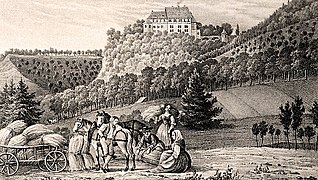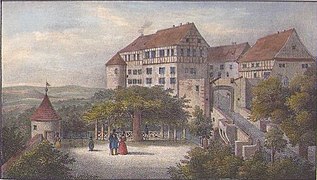Bodenstein Castle
| Bodenstein Castle | ||
|---|---|---|
|
Bodenstein Castle |
||
| Alternative name (s): | Bodenstein Castle | |
| Castle type : | Hilltop castle | |
| Conservation status: | Received or received substantial parts | |
| Standing position : | Count | |
| Place: | Wintzingerode | |
| Geographical location | 51 ° 27 '13 " N , 10 ° 20' 33" E | |
|
|
||
The Bodenstein Castle is a medieval castle above the village Wintzingerode , today part of Leinefelde-Worbis in the district of Eichsfeld in Thuringia , after the family of the later lords named. It is the best preserved castle in Eichsfeld. The hill castle is located in the Ohm Mountains in northern Eichsfeld . The village of Wintzingerode is in the valley in front of the castle. The closest town is Leinefelde-Worbis.
Today the castle is a family recreation and meeting place of the Evangelical Church in Central Germany . Thematic leisure time is offered especially during holidays and festive periods. In addition, the castle offers space for cultural activities in the Eichsfeld region, such as palace concerts, cabaret evenings and political discussion evenings.
history
Originally probably a border post between the Saxons and the Franks , the castle was probably a property of the Liudolfingian household under the early Saxon emperors after it was expanded by Heinrich I as a fortification against the Hungarian invasions. During the time of the Salian Emperor Heinrich IV , Bodenstein belonged to Count Otto von Northeim , a relative of the Liudolfinger family and leader of the Saxon aristocratic opposition.
In the following, a dynastic von Bodenstein family appears , which was probably a sideline of the Northeimers who named themselves after their new ancestral seat. For a while, this sex played a leading role in the region, which it documented above all through the foundation of the Beuren monastery in the Leinetal. In the course of the 13th century, however, it lost influence and the Bodenstein rule fell to the Guelphs in 1275 . In 1293 the castle was sold by Duke Heinrich I to the Counts of Honstein , from whom it was redeemed in 1322 as agreed. In 1327 the Welfs ceded them again to the Honsteiners, who sold them in 1337 to Hans von Wintzingerode , Otto von Rusteberg , Berthold von Worbis and Heinrich Wolf with all rights and income (including high and low jurisdiction, high and low hunting, Bergregal ), but their feudal lords remained until they died out in 1593. The close connection between the Counts of Honstein and the Lords of Wintzingerode was strengthened in the 14th century by the marriage of Dietrich von Wintzingerode with Bertrade Countess von Honstein. The lords of Wintzingerode released their co-owners on the Bodenstein until 1448 and remained the sole owners of the castle until 1945. Mentioned for the first time in 1209 with Bertholdus de Wincigeroth , they were possibly in turn a sideline of the Lords of Bodenstein. In 1525 large parts of the castle were destroyed by the train of the farmer's leader Thomas Müntzer and then rebuilt in a contemporary style. From 1530 the Lords of Wintzingerode officially introduced the Reformation in their territories, over which they came into conflict with the Honsteiners and Kurmainz .
In 1573 Count Volkmar Wolf von Honstein ceded the lordship over Bodenstein to Mainz in the Bleicheröder Treaty. Berthold XI. von Wintzingerode saw this as a breach of loyalty and declared the castle and lordship to be his free property. In 1574, 2000 men captured the castle and imprisoned the lord of the castle. In a conflict with his Scharfenstein cousins , Berthold had shot their partisans and henchman Arnold Geilhaus the year before. He has now been charged with this incident. Despite extensive defense and without taking evidence, Berthold was sentenced to death in 1575 and beheaded on September 19. Then Castles and Power Bodenstein fell to Hans and Bertram of Wintzingerode his warring with Berthold cousins, their heirs in turn in 1582 the deposit rule lost Scharfenstein.
After the Counts of Honstein died out in 1593, the Guelphs' claim to lordship and sovereignty and their protection saved the Bodenstein rule from an enforced Counter-Reformation . As a result of the Thirty Years' War , the Protestant denomination and the position of the Lords of Wintzingerode in the ruled area were further strengthened. Until 1803, it was the only non-princely family in the Old Kingdom to have all sovereign rights there without being an imperial class. The exercise of the episcopal right stood out in particular, which made the small rulership the ecclesiastical center of the Evangelicals in the lower area. In 1668 a chapel was added to the castle.
Towards the end of the 18th century, the landgrave's widow Philippine von Hessen-Kassel , a niece of Frederick the Great , stayed at the castle several times for a long time, whose owner Georg Ernst Levin von Wintzingerode , her long-time chief steward, married her in 1794 in a morganatic marriage . after she had arranged for his elevation to imperial count. As early as 1777, a few years after her marriage to the Hessian landgrave arranged by the Prussian king, she had secretly given birth to a son by her court master von Wintzingerode, at her sister Friederike Sophie Dorothea von Württemberg in Mömpelgard, who had been given the name Georg Philippson. When Philippine died in 1800, her second husband inherited a fifth of the allodial property of her family, the now extinct Margraves of Brandenburg-Schwedt , as well as the inventory from her estate, including much of the property of the great king and his siblings, including her mother counted. “This lucky one burned the old family household effects when the inheritance occurred and filled the narrow castle like a treasure chamber with these precious treasures. All good portraitists are represented, all porcelain and faience manufacturers, all famous cabinet makers, bronze and goldsmiths and miniaturists. ” ( Udo von Alvensleben , 1938) After the Landgravine's death, Wintzingerode was appointed Prime Minister of Württemberg by her nephew and became Prime Minister in 1806 he in the service of Napoleon's brother Jérôme Bonaparte , who rose to become King of Westphalia in 1807 . He sent him from 1807 to 1814 as ambassador to Paris. In this way, the castle was filled with all sorts of gifts from Bonaparte, as well as all sorts of collectibles that the Count acquired in Paris, including former items belonging to Queen Marie-Antoinette - “they don't do it here” (Alvensleben) , “in each bowl has dusty pieces of paper on which experienced connoisseurs have written down the entire novel of the piece in question ”. The glass paintings on the gentleman's gallery of the chapel were created around 1835 by the Göttingen glass painter Heinrich Friedrich Wedemeyer .
Philippine von Hessen-Kassel , painting by Johann Heinrich Tischbein the Elder, 1773
Count Georg Ernst Levin von Wintzingerode (1752–1834), glass window in the castle chapel
In 1803 the rule was incorporated into the Kingdom of Prussia . Through the coalition wars of Prussia against Napoleon I and the defeat at the battle of Jena and Auerstedt , the Eichsfeld and the Bodenstein rule came to the Kingdom of Westphalia from 1807 to 1813 . In 1815 it came back to Prussia. During the unrest in the spring of 1848, the lord of the castle, Count Heinrich Levin von Wintzingerode , had to flee to Göttingen from the threat of insurgents.
Countess Gisela von Wintzingerode
Since 1914, Gisela Countess von Wintzingerode, b. Countess von der Schulenburg -Angern (1886–1972) founded Fideikommiss Bodenstein in 1876 for her underage son after her husband was killed at the beginning of the First World War. During the Third Reich she was heavily involved in the Confessing Church . The Bodenstein was a center of church resistance against the National Socialist church struggle for the later regional bishops Hanns Lilje , Hugo Hahn and Ludolf Hermann Müller .
In 1945 the Wintzingerode family was expropriated and expelled without compensation as part of the “Democratic Land Reform” . Plans by the Thuringian monument protection authorities to set up a state museum came to nothing due to increasing inventory losses. Thereupon the authorities decided to salvage the still existing, culturally and historically valuable inventory and to store it in the poet's rooms of the Weimar City Palace. From there the items were distributed to museums, libraries and archives. From the west, Countess Gisela used her church contacts and asked the Evangelical Regional Church of the Church Province of Saxony to take care of the house, which happened after initial hesitation in 1948.
The castle is currently used as a family recreation and meeting place for the Evangelical Church in Central Germany. It can be visited on Sundays and public holidays as part of guided tours and also houses a small café.
Bodenstein court
Bodenstein Castle was the seat of the medieval judicial district of the same name. Initially, the judicial district included the places on the Ohmgebirgsplateau, Kirchohmfeld and Kaltohmfeld , as well as the deserts Seegelrode (with monastery) and Huchelheim, later Wintzingerode, Wehnde and Tastungen as well as other places that had been abandoned since then (Wildungen, Rappolderode, Kamp, Ickendorf) were added . It is not known exactly whether the original court was near Kaltohmfeld or at the castle. A Kaltohmfeld court is only known for the year 1448 and a hearing at Kaltohmfeld unter der Linde in 1545. From the 16th century, Bodenstein and Adelsborn were alternately proven for the judicial district now known as Wintzingeroder ; from the middle of the 18th century the place of jurisdiction was Wintzingerode. It is not known where the execution site or the gallows were located.
literature
- Heinrich Jobst Graf von Wintzingerode, Bernd Winkelmann, Rita Gaßmann: Bodenstein Castle in Eichsfeld. Past and present . 2nd edition, Duderstadt 1996.
- Heinrich Jobst Graf von Wintzingerode: Doing right always keeps its price. The story of the Lords of Wintzingerode and Bodenstein Castle . Bodunger Posts 8, Großbodungen 2004.
- Helmut Godehardt: A few remarks on the patronage law and pastoral care in the former Bodenstein court villages, Tastungen and Wehnde. In: EJb 13 (2005), pp. 23-35
- Heinrich Jobst Graf von Wintzingerode: The family von Wintzingerode and the Bodenstein. In: Burgen, Schlösser, Gutshäuser, Ed. Bruno J. Sobotka, Theiss Verlag Stuttgart 1995, pp. 228-236
Web links
- On the history of Bodenstein Castle PDF file
- www.burg-bodenstein.de Homepage
- www.wintzingerode.de Heinrich Jobst Count of Wintzingerode: The counts and barons v. Wintzingerode and its home town
Individual evidence
- ↑ Udo von Alvensleben (art historian) , visits before the downfall, aristocratic seats between Altmark and Masuria , compiled from diary entries and edited by Harald von Koenigswald, Frankfurt / M.-Berlin 1968, p. 134
- ↑ Jens-Uwe Brinkmann: ... in every respect completely as beautiful as such work is done anywhere ... - Porcelain painting in Göttingen. Städtisches Museum Göttingen, Göttingen 2000, p. 18, footnote 49.
- ↑ Start-up entry
- ^ Gerd-Dieter Ulferts, Schlossbergung in Thuringia, holdings of Bodenstein Castle in the Weimar collections , in: Franziska Bomski u. a. (Ed.), Looking for traces, provenance research in Weimar , Göttingen 2018, pp. 229–244
- ↑ Levin von Wintzingeroda-Knorr : Die Wüstungen des Eichsfeldes: Directory of the desert areas, prehistoric ramparts, mines, courts of law and waiting areas within the districts of Duderstadt, Heiligenstadt, Mühlhausen and Worbis. Göttingen (O. Hendel) 1903, pages 383 ff










